In-ear headphones: all about them
1. What are IEMs?
Intra-channel headphones (eng. In-Ear-Canalphone), also referred to as plugs, rarely ear monitors or (correct) IEMs (later in the article will be exactly this name, since it is very concise and the author likes it) , looks very similar to earbuds, but designed for maximum sound insulation of the ear canal of the listener. It (sound insulation) is also called, sound “sealing” - it has two functions: blocking extra noise and forming a sound area (camera) to achieve full sound. It creates such a sealing nozzle, worn on the nozzle of the earpiece and embedded in the front of the ear canal. There are also headphones where the attachment is created by the owner’s ears; they are called (by the Russian-speaking audience) custom ( custom molded earplugs ), such things serve to achieve maximum sound quality and comfort from listening.
Why choose IEMs ? Due to high portability, high-quality sound and the ability to block extra noise. Some models have long been using audio engineers; musicians performing on stage. Gags (in Russia, this name stuck more), are a variety of IEMs . When the manufacturers of in-ear headphones began to rivet them for the general consumer (iPod generation), the abbreviation IEMs became more popular (not in Russia), replacing the expression “gags”. Technical language correctly called "plugs" - IEMs . Less commonly, the abbreviation IEMs is used to denote high-quality in-ear headphones.
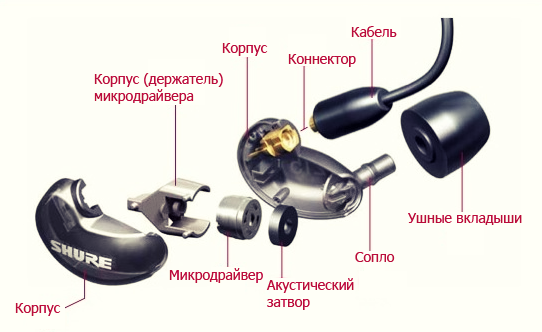
Fig. 1. Main components of IEMs.
')
2. Are IEMs inserts?
Not. IEMs and earbuds (English earbuds ) belong to two main, but different types of internal earphones (English in the earphones ). In the second, the transducers are small enough to fit tightly in the ear, and as a result, they are not “hermetic”.
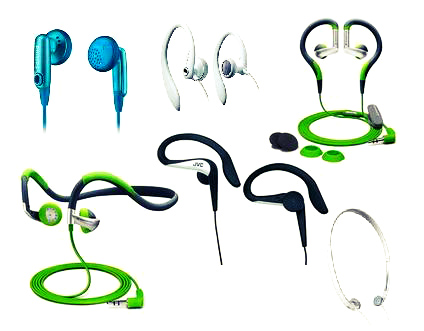
Fig. 2. Different types of liners.
Earbuds and plugs worn as open headphones, often outside the ear canal. They can be mounted with a rim on the head, or with a clip (clip) for greater comfort.
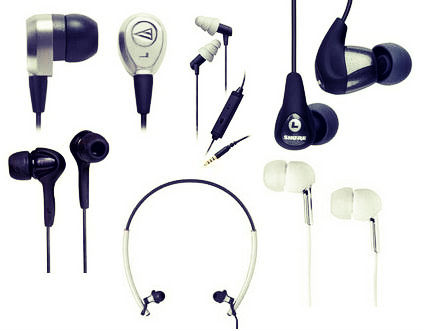
Fig. 3. Different types of IEMs.
Only IEMs are intended for partial installation in the ear canal, to create a "hermetic" seal. Previously, most (sites, shops, people) because of their misunderstanding often confused two completely different types of headphones.
3. Noise Isolation and Noise Reduction
Despite its large size, active noise-canceling headphones ( ANC ) do not always isolate from noise better than IEMs . Also in ANC, the sound quality ( English SQ ) is often second-class, or even lower (although much depends on the price, but still). There are a number of studies from the Auditory Systems Lab (Virginia Tech University) that have worked on this issue and came to this conclusion.
4. Types of converters
There are two main transducers (sensors, drivers) that are used in IEMs: dynamic and with a balanced anchor ( eng. BA ; in Russia - armature).
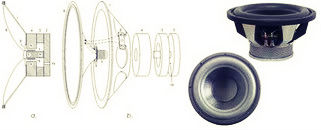 Fig. 4. Dynamic converter.
Fig. 4. Dynamic converter.The dynamic transducer (with a moving coil) is often found in low-grade IEMs because of its simplicity and low cost, in contrast to the “armature”. As a rule, the size of the former is much smaller, ranging from 3 to 6 mm in diameter. The dynamic transducer is known for its ability to create more powerful bass, because during the reproduction of sound, more air moves in it, due to the available free space (which “reinforcement” headphones with several transducers cannot boast of) that is felt by the human ear. It is worth noting that some well-known manufacturers use a dynamic transducer in their IEMs , but the sound quality remains relatively low, and this should be remembered.
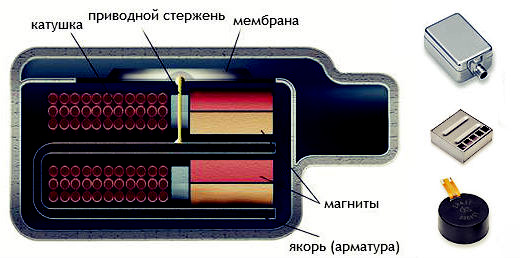
Fig. 5. Dynamic converter (inside and outside).
Reinforcement headphones have the advantage that their reproduction accuracy is much higher, the frequency range is less to remove this drawback, they use several dynamic transducers in each earphone at once, which solves this problem, each driver works on its own frequency range, increasing the total , thereby aligning the frequency response. The disadvantage of headphones with multiple converters is their high price and large size.
5. Nozzles
 Fig. 6. Options nozzles on the headphones.
Fig. 6. Options nozzles on the headphones.Headphones like IEMs , as a rule, can meet three types of nozzles: soft plastic ( English flanges, sleeves ), foam ( English foam ) and arbitrary shapes ( English mold ) with hard acrylic or soft silicone material (there are also hybrid, soft and hard forms, but less often).
Soft plastic nozzles are of two types: universal ( English universal ) and size-dependent ( English size-depended ). Universal come with two or three protrusions, it allows you to insert them into the ears to the required depth, reaching the notorious "tightness". Often headphones with such nozzles cause concern to the listener with their effects. Size-dependent soft plastic nozzles are more comfortable, as they have three sizes: small, medium and large. The user chooses what fits his ear size.
The highest "sealing", and as a result the best comfort and noise insulation in foam nozzles. This shape gives a fuller, warmer, and more pleasant sound than plastic or silicone. Foam tips also have two types associated with size. It should be noted that nozzles of this type cannot be cleaned and require replacement after several weeks of use. Some manufacturers even produce similar attachments (with different types of foams) for individual sale, in addition to the standard ones.
Black foam nozzles from Shure are the most popular [non-advertising] on the market and provide greater comfort based on (subjective) experience. Often models have a size that is indicated by dots on the bottom of the headset: one point is small, two points are middle, and three points are large. Manuals are always supplied with headphones.
6. Size of nozzles
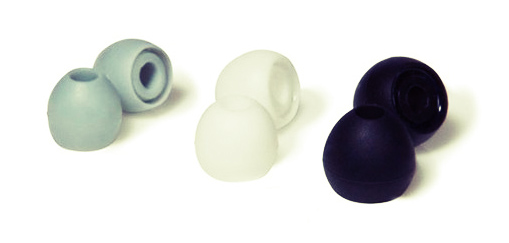
Fig. 7. Nozzles of various sizes.
The right choice of nozzle size provides an ideal “seal”, which in turn leads to maximum comfort and excellent sound. Using a large nozzle will cause pain in the ear after a few days, and the result of using a small size will be the lack of sound insulation and the predominance of high frequencies due to air leakage.
It happens that a person for a long time can not find the desired size of the nozzle, because some ears are very susceptible to foreign bodies. In this case, you will need to follow a few tips to reduce the discomfort of this problem.
7. Nozzles: Comfort Factors
We stopped at the "sealing", comfort and sound quality in silicone and plastic nozzles (about foam will not say anything, because they are very comfortable and bring discomfort to the smallest part of the audience). Consider some factors.
Factor 1: partial and full landing
Some headphones (for example, EP-630 and CX-300 ) allow you to completely, but not deeply insert the earpiece into the ear (approximately 8-9 mm), which will create less insulation, but greater comfort for the user.
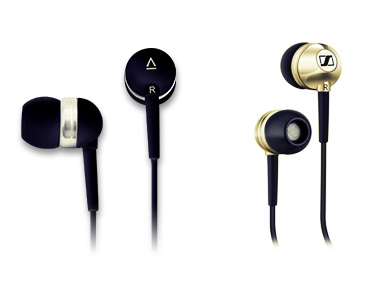
Fig. 8. Creative EP-630 and Sennheiser CX 300 respectively.
Most of the other headphones require a deeper insertion from the listener (more than 9 mm). Such a fit, as already mentioned, will create a good seal, hence a better “sealing”, as a consequence of noise insulation, but at the expense of convenience.
Factor 2: Nozzle Material
Often, the nozzles are made of soft plastic, silicone or polyvinyl chloride. Silicone is the softest of all the nozzles, as a result it is more comfortable, but not all silicone nozzles have the same softness.
 Fig. 9. Nozzles made of soft plastic, silicone and PVC, respectively.
Fig. 9. Nozzles made of soft plastic, silicone and PVC, respectively. Factor 3: nozzle thickness
A simple rule that says that the thinner the material on the nozzle, the better, but again to the detriment of sound insulation.
Factor 4: Nozzle Design
The location of the transducer also plays an important role. In general, if it is hidden compactly, which will allow to have a small earpiece, then this is good. That is why headphones with multiple transducers are considered uncomfortable.
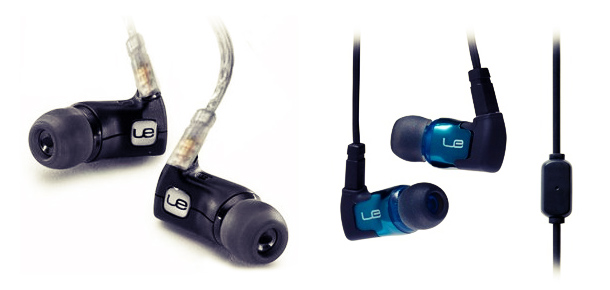
Fig. 10. Ultimate Ears Superfi and Triplefi headphones (with multiple transducers), respectively.
Consider the factors in the illustrative examples.
Example 1: Ultimate Ears headphones with a single nozzle - shallow fit, hard and thick tips, large earpiece size = not very comfortable, but good noise isolation.
Example 2: Sennheiser CX300 headphones with a single attachment - not a deep fit, soft, thin, small size of the earphone = comfortable, noise insulation is average.
Example 3: Etymotic ER-6i headphones with a triple nozzle - deep fit, soft and thick, a small earpiece - not so comfortable, but excellent sound insulation.
Example 4: Sleek Audio SA6 headphones with a double nozzle - deep fit, soft, slightly porous nozzles of medium thickness, small earpiece = convenience and excellent sound insulation.
Example 5: Head-Direct RE1 headphones with a double nozzle - deep inset, medium soft and thick, small size earphone = great convenience and good noise isolation.

Fig. 11. Headphones according to the example.
It is important to remember that it always takes time to get used to a particular nozzle, so there is no need to hurry in decisions. Personal preferences in sound change more often than in convenience and this should also be taken into account. It also happens that a person falls in love with the sound, not paying attention to the inconvenience, but when the euphoria from the sound disappears, forgotten anxieties come to him.
9. Maintain appearance and care
Maintaining a set of headphones in decent appearance can increase the quality of the original "sealing" and the life of the headphones. First of all, remember that there is no better way to preserve the life of the headphones than regular cleaning of the ear canal.
For universal headphones, nozzle pollution promises extra noise and degraded sound quality, since small debris contributes to improper air distribution. To avoid this, you must either change the nozzles to new ones, or use special tools to clean them.
Clean headphones and cable at least once a month. If you exercise with headphones, this should be done more often, especially in areas where the wire touches the skin. This will make your headphones more durable.
In no case do not use alcohol-containing cleaning liquids and bleach. It is enough to use a damp cloth and soap.
To clean the nozzles, be sure to remove them from the headphones. To do this correctly, without damaging them, take the nozzle with your thumb and index finger and twist it out of the transducer nozzle with twisting movements. Do not pull the nozzles, as this often leads to tearing and damage.
Remember that the headphone cable, like any other cable, ultimately hardens and cracks. The longer you take care of your headphones, the longer they will serve you. However, different manufacturers use cable of different quality: outwardly shaky and not high-quality cable can sometimes be very durable, and sometimes the situation is completely the opposite. Ideally, in the longer term, it is better to use interchangeable cable; In addition, a quality (very) removable cable can increase the sound quality.
Soft plastic nozzles are recommended to be washed in warm, soapy water. Be careful and do not allow the ingress of moisture, even once you wet your headphones, you can not properly repair them to the previous state. If you still wet the headphones, it is recommended to leave them in a ventilated room for 1 - 2 days - this will help the moisture evaporate.
Always wait for the headphones to dry completely before putting them in your ear.
Experimentally, it was revealed that when cleaning earpiece nozzles with hydrogen peroxide (for 15 minutes into a liquid) their lifespan is noticeably increased.
9. Static electricity
Using plugs you can get a discharge of electrostatic electricity.
Under cold conditions with low humidity, a static charge can accumulate on the body, although the ears touch only the plastic parts of the headphones, there are metal parts that are located nearby; static charge, which usually has a high voltage, is able to jump from one place to another. If the charge reaches you, it will not harm you, although it delivers unpleasant sensations.
It is important to note that such discharges are quite rare, and do not mean that your headphones are faulty; if you regularly undergo electric shocks, then most likely you have a damaged cable (sheath), and this is a warranty case.
10. Warming up (eng. Burn-it) IEMs
No definitive answer, yes or no. In general, the topic of warming is a bit religious in nature and here, mostly the answer is no, although there are people (if you search on thematic forums) and even tests where IEMs did show signs of improvement after warming up.
In general, it is very easy to check, because The warm-up time of IEMs is an order of magnitude shorter than that of any other headphones and is a maximum of a couple of days (more precisely, no more than 50 hours) of randomly playing music at a normal volume.
11. Noise from cable (born cable noise) and from body movement (born bone conduction)
Often, two kinds of complaints can be heard from demanding owners of IEMs — when the user hears unpleasant sounds caused by oscillations of IEMs that touch clothing or other objects; the second - if translated literally, it will sound like “bone conduction” - a phenomenon when the noise in the headphones (occurring inside the body) appears when walking, running, eating food, etc.
You can solve the first problem by buying a clip (and better not one) and how to attach the cable. There are also special cables that don't care if it is touched or not. Often, even on top headphones, you can find a poor quality cable, so in this matter, before buying, it is better to first watch the thematic forums or listen, “check” the cable to suit your needs. The second problem for the current day has not been solved, but as the listener correctly gets used to the noise in the background, or walks more slowly (changes shoes).
12. Portable Amplifier for IEMs
Do I need a portable amplifier ( Portable Amps ) for IEMs ? - Yes, in order to sound better, but for a small part of the headphones. Often these are high impedance IEMs , for example, Etymotic ER4S can be associated with an amplifier, but the SQ gain will be barely noticeable, unless you have a terrific ear, or are sick with the last stage of audyphilia.
Resistance and sensitivity are the easiest way to determine if a headphone amplifier is needed — if the characteristics have less than 50 ohms and 98 dB, respectively, then IEMs certainly do not need to be amplified.
13. Hiss and whistle
Occasionally, IEMs listeners may hear slight interferences at low volume levels, similar to hissing. Since Since most IEMs are very sensitive, they easily pick up electrical interferences when any other headphones ignore them. There is no actual fix for this vulnerability, but if you add a resistor to the incoming line (to increase resistance and reduce sensitivity), then there is a chance that it will work. Some sources (one type of HDD on an iPod) produce more electrical interference.
Whistling. IEMs in the frequency range from 1KHz ~ 10kHz for some “whistles” or “hisses”, which is very subjective. The problem seems to be obvious - the headphones produce a very sharp high-frequency sound, which during long-term listening can annoy, tire the listener. There are two solutions, - an equalizer and customization for yourself and (or) a choice of other nozzles, a filter.
14. Service life and non-warranty cases
Do not think that $ 500 headphones will serve you 5 times longer than $ 100 headphones. Average service life is usually written in warranty condition. High cost is not an indicator of durability.
After a breakdown, in 90% of cases the buyer (if the breakdown satisfies the conditions of the warranty contract) is provided with new headphones, since replacement is unprofitable for the manufacturer, since requires a good technical base, which often happens only on the production line.
In general, here it is better to draw an analogy with cars. If you do not have enough funds, then do not buy expensive IEMs, because they are no less susceptible to breakdowns, but require more care (in their technical structure), to everything: a more complex search for parts, their high cost.
15. IEMs and health
IEMs are often mistaken for some sort of health hazard. There are two reasons - partial hearing loss and ear infections. Here, again, the point is correct use.
Firstly, it is logical that if you listen to music at high volume for a long time, this will lead to hearing loss, regardless of which headphones (speakers) were used. IEMs have an advantage - no need to twist the volume to the maximum to overcome external noise. The default volume on most players should meet the needs of the average listener. Also, it is necessary to consider incorrect guesses that the hearing can spoil due to the fact that the sound is closer to the eardrum. There are several studies on security: 1 , 2 .
Second, by inserting any object into your ear, your body will react with an increased production of earwax. This is such a defensive reaction against an increase in bacterial populations in a moist environment; cleaning the ear canal is recommended to be done regularly. Actually, the less often you take off the headphones, the more sulfur you accumulate, and with noticeable hearing loss, you should immediately consult a doctor, excluding listening to in-channel headphones, because this can cause damage to the gray eardrum, and as a result - hearing loss.
One important note: people, even if they do not subject themselves to loud listening to music, but listening to music for a very long time, can still have problems. There is a study that even at low volume (45 ~ 55dB), listening without affecting hearing is harmful to health: people are prone to developing serious diseases, both physical and psychological. It is not recommended to listen to music continuously, even at low volume, the love of music 24/7 directly damages health.
To summarize: keep your ears clean, do not listen to music for too long (for example at night, and after on the way to work, at work, from work, at night ...), do not overestimate the volume (there is a lot of research where it is proven that reduces hearing for short periods of time) - remember, hearing loss is an irreversible disease; keep common sense over emotional pleasure.
16. Frequency response of IEMs
An interesting fact is when many people say that IEMs are full of details, accuracy; However, the range of most of these headphones, if you look at the characteristics, does not actually exceed 16kHz.
Although the human range of the sound perceived by the human ear is somewhere in the region from 20Hz to 20000Hz, most adults (after ~ 20 years) cannot actually hear sound above 16kHz; High frequencies are considered to range from 5kHz to 16kHz, - there are all the details, most of them in the lower region.
Perhaps intelligent and well-read listeners will argue here, because, although people cannot hear the sound above 20kHz, they can feel the presence of ultrasound (harmonious distortion), which has a positive effect on SQ. However, considering that almost all popular audio formats have a limit of 20kHz, it can be concluded that most music is already limited within this framework; and, as a result, there is no need to believe a new sound from the headphones, if their range goes beyond 20kHz.
17. Are IEMs worth their money?
It often happens that ordinary (overhead) headphones sound better than IEMs at the same price. However, IEMs have their advantages over other types of headphones, such as noise isolation and mobility, which are also worth considering. You need to decide on your priorities, which is better for you: SQ, portability, or something else? With what, when and where are you going to use your headphones. As soon as a decision is made, you need to decide on a budget and go to some audio forum (doctorhead.ru, pleer.ru, hi-fi.ru), search for what you want or ask people (for the thousandth time ).
18. IEMs - Pros and Cons
[+] - Noise;
[+] - The best combination of portability and SQ;
[-] - Requires more care and support;
[-] - Narrow sound stage;
[-] - High price.
19. What to choose if there is a budget?
IEMs can be broken down into price categories (subjectively).
The lowest grade of the segment, up to $ 50 , is a budget level - this includes dynamic IEMs that provide relatively poor noise insulation (they often have a single flange attachment that is not foamy). They sound a little better or on the same level as the earbuds . Usually in such models the bass prevails, sometimes there are also headphones with good high frequencies. In general, everything is very similar to liners, but with isolation.
Price from $ 50 to $ 100 , is essentially entry into the class, the first level of real IEMs . There are dynamic headphones with the best SQ, and one-way reinforcement headphones. Any earbuds up to ~ $ 100 are worse than headphones in this category.
Price from $ 100 to $ 300 , - middle class IEMs . There are headphones with dynamic and two-way (rebar) transducers. For most music lovers, these are high-end headphones. In this budget, you can find yourself custom headphones or collect (ordering modding) them for yourself. Perhaps the best value for money among IEMs .
The price is above $ 300 , - headphones of the highest class, - Hi-End, if officially. Often, in this range, the price is clearly too high (it can easily be more than $ 1000). As for quality, in reality there are no special advantages, compared to what the manufacturer advertises and how the manufacturer positions itself.
Be careful. First, the official price should be viewed on the manufacturer’s website, and specifically for the country where the headphones were manufactured, or in which country the company is based, often the manufacturers for some countries (including Russia) overestimate the cost. Secondly, the price is often determined by demand.
And, most importantly, you should not trust instructions above 100% (the market price cannot reflect the cost): it happens that great IEMs may become undervalued, or not great ones - overvalued. The best way to choose is to go to the store and listen, or read the appropriate forums, ask experienced people.
20. Custom headphones

Fig. 13. UE11 Pro, worth over $ 1000 (but not so bad) .
This is a product created in the acoustic laboratory from scratch: experts calculate all the factors influencing the sound and create headphones that are most suitable both for the shape of your ears and for your perception of sound.
As a rule, headphones of this category beat records in price among the rest, but not without budget brands ( for example, “mylivewires” ), of course; - qualitatively and at an affordable price, unlike, for example, products of the company “Ultimate ears”, sometimes even the hardware component is used the same.
There are a few things you need to know before purchasing custom headphones.
In order for the headphones to impress you, they need to be “tailored” to your ears, but even the most ideal fit with the most ideal headphones can not be compared with real professional, “audiophile” headphones. To all, the "fit" may have to be done several times, because the material (less often the ears) can be deformed, which will lead to another waste of money - all this clearly confirms the main drawback of IEMs - the high cost.
For a long time, it was considered from which material (soft or hard) nozzles should be in order to create the best comfort and compaction; and the recent trend is more behind soft tips, even among professionals. However, there are studies that believe that there is no clear advantage between the material, arguing that the effect of Streisand.
Unlike ordinary IEMs,product life cycle is rather short and is estimated at about 4 years, but there is no definite answer about this; - Much depends on the physiology. The reason is interesting - your ears will grow, change. As a result, you simply cannot insert them into one “beautiful” day. You will need to re-do the cast, and so on for several years. It happens that some companies do not make new tips for old headphones ( eng. Remolding ), but offer the same, new model with a discount (or without, less often). There are still companies that will make you attachments, even if you don’t have their headphones, it’s just profitable for them.
It may be interesting to many: how does the manufacturer know the shape of my ear, if it is somewhere in another country, and has never been to Russia - everything is simple - you make a cast (~ 1 thousand - 3 thousand rubles) and send to the manufacturer.
21. List of manufacturers
And lastly, in order.
Universal IEMs:
- AIAIAI
- AKG
- Apple
- Atomic Floyd
- Audio-Technica
- BeyerDynamics
- Bose
- Brainwavz by MP4Nation
- Creative
- Cresyn (Korea)
- CrossRoads (Singapore)
- Denon
- DUNU (China)
- EarSonics (France)
- ECCI (China)
- Etymotic
- Final Audio Design (Japan)
- Fischer Audio (Russia)
- Future Sonics
- Grado
- Head-Direct / HiFiMAN
- Hippo (Singapore)
- JBL (USA)
- j-phonic (Japan)
- JAYS
- Jvc
- Kenwood
- Klipsch
- Maximo
- MEElectronics
- Microsonic Music
- Monster
- NuForce
- Ortofon (Japan)
- OVC (China)
- Phiaton
- Phonak (Swiss)
- Radius (Japan)
- Sennheiser
- Shure
- Sleek Audio
- SonoCore (Korea)
- Sony
- SoundMAGIC (China)
- Spider
- SunRise-Audio (Vietnam)
- Thinksound
- Ultimate Ears
- V-moda
- ViSang (China)
- Vsonic (China)
- Westone
- Woodees
- Xears (Germany)
Custom IEMs:
- 1964 Ears (with reshell service, US)
- Advanced Communication Solutions (UK)
- Alien Ears (with reshell service, US)
- Ambient Acoustics (Ukraine)
- Canal Works (Japan)
- Clear Tune Monitors
- Compact Monitors (Germany)
- DRM Earz
- EAR inc.
- EarPower (Italy)
- EarSonics (France)
- EarSound Customs
- Fabulous Earphones (Germany)
- Fidelity Custom Earphones
- Fisher Hearing (with reshell service, US)
- FitEar (Japan)
- Future Sonics
- Insono (France)
- JH Audio
- Kozee Solution (with reshell service, US)
- LiveWires
- Microsonic Music
- Minerva Hearing Protection (UK)
- Puretone Music
- Rooth (with resehll service, China, via Japan distributor)
- Sensaphonics
- Sleek Audio (with custom artwork service)
- Spiral Ear (Poland)
- StarKey
- Thousand Sound (China)
- Ultimate Ears
- Unique Melody (with reshell service, China)
- WanXuan (Hong Kong)
- Westone
- Xtreme Ears (Brazil)
Source: https://habr.com/ru/post/202276/
All Articles